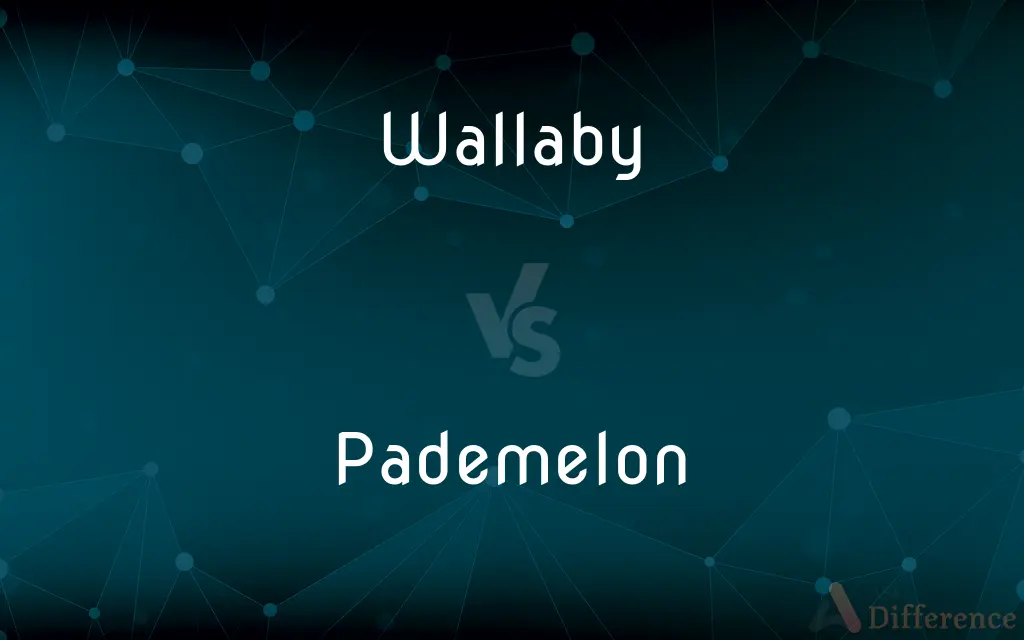Wallaby vs. Pademelon — What's the Difference?
By Tayyaba Rehman & Urooj Arif — Updated on April 7, 2024
Wallabies are medium-sized marsupials similar to kangaroos but smaller, found mainly in Australia and New Guinea. Pademelons are smaller, stockier relatives of wallabies, with shorter tails and legs, living in forests of Australia and New Guinea.

Difference Between Wallaby and Pademelon
Table of Contents
ADVERTISEMENT
Key Differences
Wallabies are known for their powerful hind legs and long tails, which aid in balance and movement through open landscapes or sparse woodlands. They are adaptable, existing in a variety of habitats, from coastal areas to forests. Pademelons, on the other hand, are adapted for dense forest habitats where their compact bodies allow easier navigation through thick vegetation. They have shorter, thicker tails and legs compared to wallabies, suited for their life in more enclosed spaces.
The diet of wallabies primarily consists of grasses and leaves, with their food choices adapting based on the availability within their habitats. They are more likely to be seen grazing in open areas. Pademelons, however, are mostly nocturnal feeders, relying on the cover of darkness to forage for leaves, fruits, and grasses in the forest understorey, showing a preference for more diverse plant material due to their forested environments.
In terms of social behavior, wallabies can be found both solitarily and in small groups, depending on the species and the environmental conditions. Their social structure tends to be more flexible. Contrastingly, pademelons are generally more solitary creatures, coming together only in favorable feeding grounds or during mating season, highlighting their more reclusive nature.
Reproduction in wallabies involves a gestation period that leads to the birth of a very small, underdeveloped joey, which then continues to develop in the mother's pouch. Pademelons share this reproductive strategy, with subtle differences in gestation periods and pouch life based on species and environmental factors. Both have adapted their breeding cycles to the harsh and unpredictable climates of their habitats.
While wallabies have adapted to a wider range of environments and can be found in both Australia and New Guinea, pademelons are more restricted to forested areas, making them less visible to humans. This habitat specialization influences their behavior, diet, and even their risk of predation.
ADVERTISEMENT
Comparison Chart
Size
Medium-sized, larger than pademelons.
Smaller, stockier, with shorter tails and legs.
Habitat
Varied, including open landscapes and sparse woodlands.
Dense forests, primarily in Australia and New Guinea.
Diet
Grasses and leaves, adaptable based on availability.
Leaves, fruits, and grasses, mostly nocturnal feeders.
Social Behavior
Solitary or in small groups, flexible social structure.
Generally solitary, more reclusive.
Reproduction
Gestation leading to pouch development of the joey.
Similar reproductive strategy, with slight variations.
Compare with Definitions
Wallaby
A smaller relative of kangaroos, known for living in a variety of habitats.
The wallaby hopped across the open field with ease.
Pademelon
Shares a similar reproductive process with wallabies.
The pademelon joey stayed in its mother's pouch for months before emerging.
Wallaby
Characterized by powerful hind legs and a long tail for balance.
The wallaby used its long tail to balance while grazing.
Pademelon
Feeds nocturnally on a diverse diet of forest vegetation.
At night, the pademelon forages for leaves and fruits.
Wallaby
Can adapt its diet based on environmental conditions.
Wallabies in the coastal area feed on different grasses than those in woodlands.
Pademelon
Leads a mostly solitary life, rarely seen in groups.
The solitary pademelon was spotted near a forest clearing.
Wallaby
Exhibits a flexible social structure.
The solitary wallaby joined a small group near the waterhole.
Pademelon
Has shorter legs and a thicker tail than its wallaby relatives.
The pademelon's short legs are perfect for its forest home.
Wallaby
Reproduces with a joey developing in the pouch.
The wallaby's joey peeked out from its mother's pouch.
Pademelon
A small, stocky marsupial adapted to dense forest living.
The pademelon navigated through the underbrush with ease.
Wallaby
A wallaby () is a small or middle-sized macropod native to Australia and New Guinea, with introduced populations in New Zealand, Hawaii, the United Kingdom and other countries. They belong to the same taxonomic family as kangaroos and sometimes the same genus, but kangaroos are specifically categorised into the four largest species of the family.
Pademelon
Pademelons are small marsupials of the genus Thylogale found in Australia and New Guinea. They are some of the smallest members of the family Macropodidae.
Wallaby
An Australasian marsupial that is similar to, but smaller than, a kangaroo.
Pademelon
Any of several small macropods of the genus Thylogale of New Guinea, Australia, and adjacent islands, having short thick tails and sometimes considered to be small wallabies.
Wallaby
Any of various marsupials of the family Macropodidae of Australia and adjacent islands, resembling kangaroos but generally smaller.
Pademelon
Any species of the genus Thylogale of small macropods.
Wallaby
Any of several species of marsupial; usually smaller and stockier than kangaroos
Pademelon
Alternative form of paddymelon
Wallaby
Any one of numerous species of kangaroos belonging to the genus Halmaturus, native of Australia and Tasmania, especially the smaller species, as the brush kangaroo (Halmaturus Bennettii) and the pademelon (Halmaturus thetidis). The wallabies chiefly inhabit the wooded district and bushy plains.
Pademelon
Any of several small reddish-brown wallabies of scrubby areas of Australia and New Guinea, especially those belonging to the genus Thylogale; a paddymelon. See Wallaby
Wallaby
Any of various small or medium-sized kangaroos often brightly colored
Pademelon
Small reddish-brown wallabies of scrubby areas of Australia and New Guinea
Common Curiosities
How can you differentiate a wallaby from a pademelon?
Wallabies are generally larger with longer tails and legs, while pademelons are smaller with compact bodies suited for forested environments.
How do wallabies and pademelons reproduce?
Both have a similar reproductive strategy where a tiny joey is born and continues to develop in the mother's pouch.
Can wallabies and pademelons be found together?
While they may share some overlapping territories, their preferred habitats generally differ, with wallabies more adaptable to various environments and pademelons sticking to dense forests.
Do wallabies have predators?
Yes, wallabies face threats from natural predators like dingoes and birds of prey, as well as from humans and habitat loss.
Are pademelons nocturnal?
Yes, pademelons are mostly nocturnal, foraging for food at night to avoid predators.
Where do wallabies and pademelons live?
Wallabies inhabit a range of environments from open fields to woodlands, whereas pademelons are found in dense forests.
What do wallabies eat?
Wallabies primarily feed on grasses and leaves, with their diet adapting to the availability of food in their habitat.
What is the social structure of pademelons?
Pademelons are generally solitary, coming together only for feeding in abundant areas or during the mating season.
Are pademelons endangered?
Some pademelon species are under threat due to habitat destruction and predation, highlighting the need for conservation efforts.
How do pademelons adapt to forest life?
Their compact bodies, short legs, and thick tails are suited for navigating and foraging in dense vegetation.
Share Your Discovery

Previous Comparison
Shaft vs. Tree
Next Comparison
Loaf vs. LoavesAuthor Spotlight
Written by
Tayyaba RehmanTayyaba Rehman is a distinguished writer, currently serving as a primary contributor to askdifference.com. As a researcher in semantics and etymology, Tayyaba's passion for the complexity of languages and their distinctions has found a perfect home on the platform. Tayyaba delves into the intricacies of language, distinguishing between commonly confused words and phrases, thereby providing clarity for readers worldwide.
Co-written by
Urooj ArifUrooj is a skilled content writer at Ask Difference, known for her exceptional ability to simplify complex topics into engaging and informative content. With a passion for research and a flair for clear, concise writing, she consistently delivers articles that resonate with our diverse audience.














































